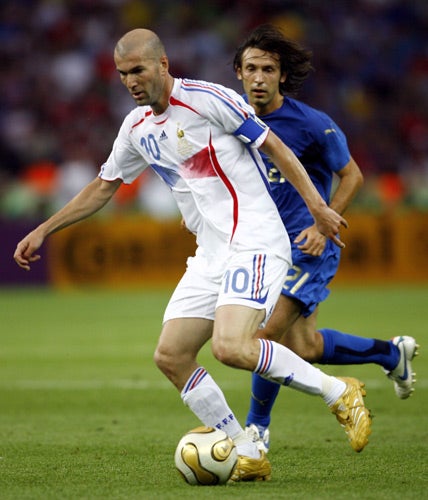Why sports documentaries are no longer one-dimensional fan-fests
Kaleem Aftab charts how sports documentaries have moved into the art-house arena

Making sports documentaries was once looked upon as the cinematic equivalent of scoring own goals. They were traditionally the preserve of television or, more recently, the straight-to-DVD market. They had titles like The 100 Best Goals of the Season or David Beckham: Life of an Icon. They were films, aimed at sports fans, with no pretence of any cinematic value. However, the appearance of two sports documentaries at the Cannes Film Festival this year, James Toback's Tyson and Emir Kusturica's Maradona, and the forthcoming documentary on Kobe Bryant by Spike Lee, is proof that sports documentaries have become respectable.
The release of Hoop Dreams in 1994 became the benchmark for a new type of sports documentary, one with cinema rather than TV audiences in mind. Like a young sportsperson making a first breakthrough, the film came out of nowhere to take audiences by surprise, ultimately going on to win the Oscar for Best Documentary. What made Hoop Dreams so watchable was that it wasn't really about basketball at all. It was the story of two African-American working-class kids, William Gates and Arthur Agee, who saw basketball as a way out of poverty and social housing.
Director Steve James followed the two prospects for five years and captured a rare insight into race in America, and into the harsh realities of life near the poverty line.
The rise in stature of sports documentaries has seen Stacy Peralta become the first director to earn "auteur" status just for making sports documentaries. Both Dogtown and Z-Boys (2002), which surveyed the growth of skateboarding in the late Sixties by following a group of skaters from Peralta's home turf of Venice Beach, California, and 2004's Riding Giants, which took a similar look at the evolution of surfing, were more concerned with the life and culture of southern California at the time than they were with showing or providing any great insight into the sports on display.
In 2006 came Zidane: A 21st Century Portrait by Douglas Gordon and Philippe Parreno. For this film, all of their cameras were trained solely on Zinedine Zidane during a match between his Real Madrid team and Villarreal. Part film, part art-installation, the whole match is shown only from the perspective of Zidane. With a soundtrack from Mogwai, it's infinitely superior to Sky Sports's PlayerCam.
The old formulaic approach has been put to bed by film-makers trying to find stories about sports stars that wouldn't appear in the sports pages. This can clearly be seen in Fred Poulet and Vikash Dhorasoo's fascinating documentary Substitute. Poulet says: "I wasn't looking to make a sports film when I gave the camera to Vikash Dhorasoo during the 2006 World Cup." The result is less about the World Cup than a film about alienation and being left out of the group.
Director James Toback has had unprecedented access to Tyson. His film sees Tyson talk about his life to the camera, and Toback cuts the 30 hours of footage of interviews to give an insight into the way the former heavyweight champion of the world sees the world. He talks about his rape conviction, money problems and religion. The only voice in the documentary is Tyson's, and very occasionally the footage is interspersed with Tyson boxing. One memorable scene sees Tyson reveal that he had gonorrhea when he first fought for the heavyweight crown, against Trevor Berbick.
Access and a different, innovative, perspective are the key to these new documentaries. The failings of Kusturica's Maradona are largely down to the fact that, in three years, the Argentine footballer agreed to sit down and be interviewed by the director only twice. We never feel like we get into the heart and soul of Maradona, and consequently Kusturica tries to plug the gaps, not with archive footage, but by making outlandish comparisons between characters in his own earlier films and Maradona. Kusturica is clearly aware that, in the YouTube age, footage of stars performing is readily accessible and a unique angle must be found.
Lee, by contrast, was so wowed by Zidane that he decided to use the same approach to film basketball player Kobe Bryant in action. He also announced at Cannes that he is making not one, but two, sports documentaries, as the NBA has commissioned him to make a film on basketball legend Michael Jordan.

Watch Apple TV+ free for 7 days
New subscribers only. £8.99/mo. after free trial. Plan auto-renews until cancelled

Watch Apple TV+ free for 7 days
New subscribers only. £8.99/mo. after free trial. Plan auto-renews until cancelled
The way film-makers are now approaching sports documentaries is distinctive: Tyson is a world away from Maradona, and the emphasis is on making the events smaller and more personal. Where once a sports documentary would emphasise how an event rocked the world, the latest documentaries are far more taken by how such events have emotionally affected an individual.
Subscribe to Independent Premium to bookmark this article
Want to bookmark your favourite articles and stories to read or reference later? Start your Independent Premium subscription today.

Join our commenting forum
Join thought-provoking conversations, follow other Independent readers and see their replies